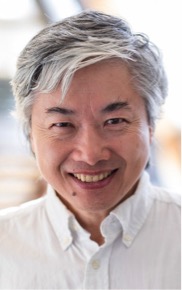Shuguang Zhang
Shuguang Zhang is an American biochemist. He is a Principal Research Scientist at the MIT Media Lab's Laboratory for Molecular Architecture.[1] Shuguang Zhang's research focuses on designs of biological molecules, particularly proteins and peptides. He has published over 160 scientific papers, which have cumulatively been cited over 31,000 times with an h-index of 85.[2]
Shuguang Zhang | |
|---|---|
 | |
| Born | Chongqing, China |
| Known for | self-assembling peptides |
| Academic background | |
| Education | University of California, Santa Barbara (PhD), Sichuan University |
| Doctoral advisor | Eduardo Orias |
| Academic work | |
| Discipline | Biochemistry |
| Sub-discipline | Molecular Architecture |
| Institutions | Massachusetts Institute of Technology |
| Website | https://www.media.mit.edu/people/shuguang/overview/ |
Early life and education
Shuguang Zhang received his B.S. in biochemistry from the Sichuan University in Chengdu, China in 1980. In 1988 he received his Ph.D.in USA in Biochemistry & Molecular Biology from the University of California, Santa Barbara (UCSB). He joined the Massachusetts Institute of Technology in 1988 to work with Alexander Rich as an American Cancer Society Postdoctoral Fellow.[3]
Career and Scientific Work
Zhang is the widely acknowledged founder of the field of self-assembling peptides, which stems from a discovery he made in 1990. He discovered the first Z-DNA binding protein, which he named Zuotin. In sequencing the Zuo gene, and the subsequent analysis of its Zuotin protein sequence, he noticed a remarkable alternating sequence where every other amino acid is hydrophobic alanine and positively charged lysine or negatively charged glutamic acid with the sequence n-AEAEAKAKAEAEAKAK-c (EAK16), the discovery of the first self-assembling peptides.
Zhang contributed decisevely to a method termed the QTY Code.[4] In 2019, Zhang and his team successfully designed proteins which can stop cytokine storms. This discovery is directly relevant to the treatment of COVID-19 patients.[5]
Zhang is the founder of the biopharmaceutical companies 3-D Matrix Medical Technology and OH2 Laboratories. He served on the board of scientific advisors for Acorda Therapeutics (1995-2001). He serves on the editorial board of PLoS One (since 2006) and on the advisory board for World Scientific Book Series: Series in Structural Biology (since 2011).
Shuguang Zhang discovered a group of peptides that spontaneously spontaneously organize into aggregates and networks under physiological conditions. He received numerous recognitions and awards for this discovery. Zhang is also a consultant to numerous companies worldwide. His company 3-D Matrix developed numerous products for tissue regeneration, wound healing and nerve regeneration. Shuguang Zhang founded another company NZ3 to utilize lipid-like peptide nanostructures, which was acquired by 3-D Matrix.
Awards [6][7]
- 1998-2002: Whitaker Foundation Investigator at MIT
- 2003: Fellow of Japan Society for Promotion of Science (JSPS fellow)
- 2004: R&D100 award for 3DMatrix
- 2006: Guggenheim Fellowship (sabbatical at the University of Cambridge)
- 2006: Wilhelm Exner Medal of Austria
- 2010: Elected to Austrian Academy of Sciences
- 2011: Elected to American Institute of Medical and Biological Engineering
- 2013: Elected to US National Academy of Inventors
- 2020: Emil Thomas Kaiser Award, The Protein Society [8]
Selected Publications
- Wang, A. H.; Quigley, G. J.; Kolpak, F. J.; Crawford, J. L.; van Boom, J. H.; van der Marel, G.; Rich, A. (1979). "Molecular structure of a left-handed double helical DNA fragment at atomic resolution". Nature. 282 (5740):680-686. Bibcode: 1979 Natur.282..680W.
- Zhang, S., Lockshin, C., Herbert, A., Winter, E. & Rich, A. (1992) "Zuotin, a putative Z-DNA binding protein in Saccharomyces cerevisiae." EMBO. J, 11, 3787–3796.
- Zhang, S. et al. (1993). "Spontaneous assembly of a self-complementary oligopeptide to form a stable macroscopic membrane." Proc. Natl. Acad. Sci. USA 90, 3334–3338.
- Hao, SL et al. (2020) QTY code-designed water-soluble Fc-fusion cytokine receptors bind to their respective ligands. QRB Discovery 1, Cambridge University Press.
References
- http://news.mit.edu/2020/proteins-cytokine-storms-covid-19-0416
- https://scholar.google.com/citations?user=lZ-zpSsAAAAJ&hl=en&oi=ao
- https://www.media.mit.edu/people/shuguang/overview/
- https://cen.acs.org/materials/inorganic-chemistry/Making-chimeric-versions-chemokine-receptors/97/i47
- http://news.mit.edu/2020/proteins-cytokine-storms-covid-19-0416
- https://www.moleculararchitecture.org/news
- https://www.media.mit.edu/people/shuguang/overview/
- https://www.media.mit.edu/posts/emil-thomas-kaiser-award/